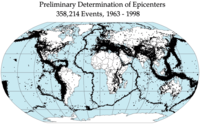
Photo from wikipedia
Channels usually contribute to the accumulation of reservoirs and their identification is useful in the good placements for mining and oil field development. We consider the task of channel detection… Click to show full abstract
Channels usually contribute to the accumulation of reservoirs and their identification is useful in the good placements for mining and oil field development. We consider the task of channel detection as a regression problem and propose a workflow to identify the channels in seismic volumes with complex structures using an end-to-end 3-D convolutional neural network (CNN). To train the network, we automatically generate a training dataset containing more than 19 000 3-D synthetic seismic volumes and the corresponding channel labels, which are shown to be sufficient to train our network. Although only trained on the synthetic dataset, the network can automatically learn informative features for channel identification. Multiple synthetic and field applications show that the network can accurately and efficiently separate all the channel reflections in 3-D seismic volumes with complex structures. With an NVIDIA P100 GPU, the predicting application takes only 0.6 h for a 10 GB seismic volume with size $1201 \times 1601 \times 1351$ .
Journal Title: IEEE Geoscience and Remote Sensing Letters
Year Published: 2022
Link to full text (if available)
Share on Social Media: Sign Up to like & get
recommendations!